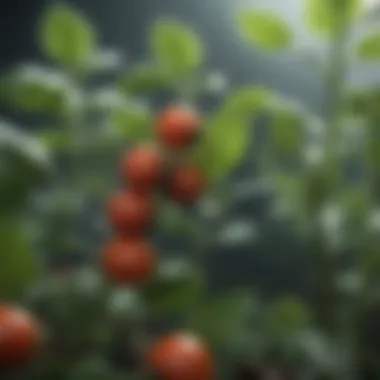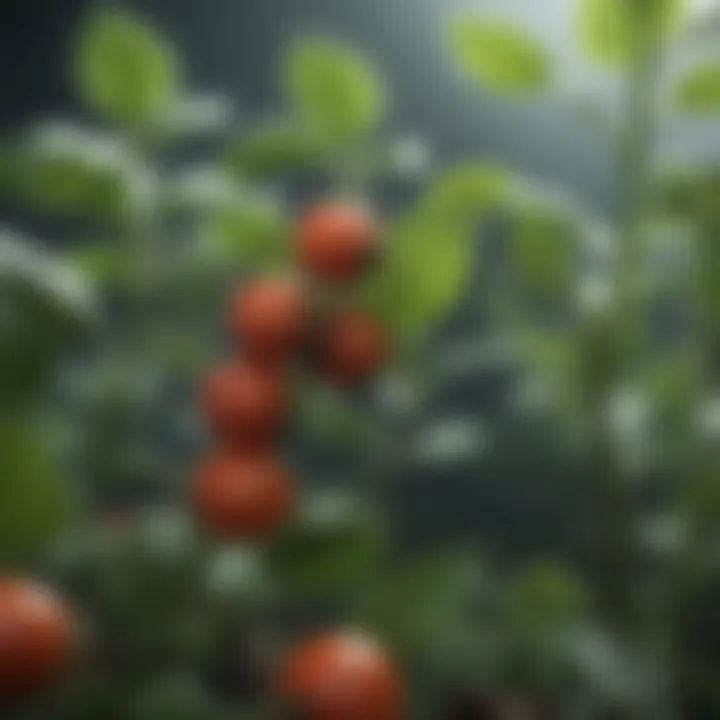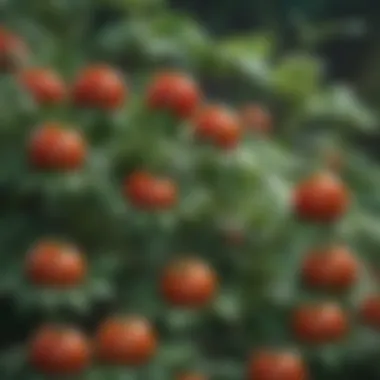Insect Interactions: Impact on Tomato Cultivation


Intro
The relationship between insects and tomato plants is complex and multifaceted. Understanding this dynamic is essential for effective tomato cultivation. Insects can act as pollinators, but they often serve as pests that damage crops. This article will explore the various interactions, focusing on both beneficial and harmful insects that affect tomato plants.
Insects play a crucial role in the ecosystem surrounding tomato crops. Their behaviors, influences, and the ecological balance they maintain can significantly impact yields and the overall health of tomato plants. With the rising interest in sustainable agriculture, it is increasingly important to examine these interactions thoroughly. By doing so, researchers, educators, and agricultural professionals can devise better management strategies that favor plant health and productivity.
Preamble to Tomato Plants and Their Ecosystem
Understanding the ecosystem surrounding tomato plants is essential in the context of agriculture, biology, and pest management. Tomato plants belong to the Solanaceae family and are grown in various environments worldwide. Their growth is influenced not only by environmental conditions but also by a range of insects that can act as either pests or beneficial allies.
Biological Characteristics of Tomato Plants
Tomato plants are herbaceous perennials, although they are usually grown as annuals. They exhibit a sprawling growth habit characterized by a robust stem that can reach up to two meters in height. The leaves are compound and have a distinctive jagged edge. The flowers are typically yellow and can be solitary or grouped in clusters. Fruit development begins after successful pollination, usually requiring twelve to sixteen weeks from planting to harvest. Understanding these biological traits is crucial. The growth conditions, such as soil type and moisture requirements, determine the plant's health and yield.
Role of Tomatoes in Agriculture
Tomatoes rank among the most important agricultural crops globally. They serve as a key component in various diets and culinary traditions. They are high in vitamins such as C and K and contribute to a balanced diet. Farmers cultivate tomatoes for fresh consumption and processing into sauces, juices, and canned products. The economic impact is significant, influencing local economies and global markets. Thus, understanding insect interactions is not just about plants but encompasses economic and nutritional dimensions.
Preface to Common Insects Affecting Tomatoes
Insects play dual roles in the ecosystem of tomato plants. Some insects, like aphids and whiteflies, are notorious pests. They can sap the vitality of tomato plants and transmit diseases. In contrast, other insects, including bees and ladybugs, promote pollination and help control pest populations. The balance between these insect groups is delicate. It influences not just tomato health but also the overall agricultural productivity. Examining these interactions helps inform strategies for managing pest populations effectively.
The relationship between insects and tomato plants is a fine interplay of competition and cooperation, which directly affects agricultural practices.
This overview suggests a need for comprehensive insights into the ecosystem of tomato plants. In the following sections, we will delve deeper into the taxonomy, ecological impacts, and management strategies related to these essential crops.
Insect Taxonomy Relevant to Tomato Cultivation
Understanding insect taxonomy is vital for effective tomato cultivation. It provides a framework for identifying different insect species that interact with tomato plants, including both pests and beneficial insects. This knowledge helps in understanding the ecological balance within tomato farming.
Taxonomy aids in recognizing which insects pose threats to tomato plants. By knowing the specific characteristics of major pests, farmers can apply targeted measures for control. Furthermore, distinguishing beneficial insects from harmful ones is crucial for maintaining a healthy ecosystem that supports crop health.
Identification of Major Pests
Several pest species significantly impact tomato plants. Recognizing these major pests is essential for farmers and researchers. Common pests include:
- Aphids: These small, soft-bodied insects can cause wilting and stunted growth. They feed by sucking sap from plants.
- Whiteflies: Another sap-sucking insect, whiteflies tend to cluster on the underside of leaves, leading to yellowing and potentially the spread of viral diseases.
- Spider Mites: Often mistaken for small specks of dirt, these mites can cause leaf discoloration and webbing. Heavy infestations can lead to plant death.
- Tomato hornworms: These caterpillars are large and green, and they can defoliate plants rapidly.
Identifying these pests early is crucial to managing their populations effectively.
Beneficial Insects and Their Roles
While some insects are detrimental, others play a positive role in tomato cultivation. Beneficial insects assist in pest control and pollination. Important beneficial insects include:
- Ladybugs: They consume aphids and other pests, helping to control their populations.
- Praying mantises: As generalist predators, they can eat various insects, offering a natural method for pest control.
- Bees: Essential for pollination, bees help improve tomato yields by enhancing fruit set.


Encouraging beneficial insects is a sustainable approach to managing pests while maintaining crop health.
Life Cycles of Key Insect Species
Understanding the life cycles of key insect species is critical for implementing effective pest management strategies. Most insect species undergo metamorphosis, which includes several stages:
- Egg: The initial stage where pests lay eggs often on or near tomato plants.
- Larva/Nymph: This stage is where pests actively feed on the plant, causing damage.
- Pupa: In some species, this is a period of transformation where pests change into their adult form.
- Adult: The final stage, where they reproduce, continuing the cycle.
For example, tomato hornworms lay eggs that hatch into larvae, leading to significant crop damage. By understanding these life stages, interventions can be timed more effectively, preventing population explosions.
Knowledge of insect taxonomy and life cycles can significantly impact tomato production.
By integrating these insights into cultivation practices, growers can optimize pest management, enhance yield, and ensure a more productive agricultural environment.
Ecological Impacts of Insects on Tomato Plants
Insect interactions with tomato plants play a critical role in shaping the ecosystem within agricultural settings. Understanding these interactions is vital for developing effective management strategies for pest control while enhancing tomato plant productivity. %These ecological impacts encompass both direct and indirect effects, which are important for researchers and agricultural practitioners alike.
Direct Effects of Insect Infestations
Direct effects of insect infestations can significantly influence the health of tomato plants. Common pests, such as aphids, whiteflies, and spider mites, often consume the plant's sap, resulting in reduced vigor. This feeding behavior may lead to several visible symptoms including yellowing of leaves, stunted growth, and in more severe cases, plant death. Issues such as leaf curl and wilting are also common, indicating stress due to pest activity.
Pests can also introduce diseases through their feeding. For instance, aphids may carry viral infections that can spread rapidly among plants. This not only affects the individual plant’s health but can also lead to broader infestations throughout a garden or field. Additionally, the presence of insect infestations tends to make tomato plants more attractive to secondary pests, exacerbating the problem.
Indirect Consequences on Tomato Growth and Yield
Indirect consequences of insect infestations extend beyond the immediate damage caused by pests. The presence of damaging species can hinder pollination processes by disrupting beneficial insect activity. While pollinators generally contribute to fruit set and overall productivity, their populations can decline in the presence of aggressive herbivores.
The yield of tomato crops often diminishes as pest-related stress factors increase. These reductions in yield could result from several factors:
- Translocation of nutrients: Insect infestations can alter the nutrient transport within the plant, making essential resources harder to access.
- Stress-induced flowering: Under stress from pests, plants might divert energy from fruit production to survival, thereby limiting yield.
- Quality of fruits: Insects can also affect the size and flavor of tomatoes, reducing their market value.
"Understanding the ecological impacts of insects is essential for sustainable agricultural practices."
Insect Behavior and Interactions with Tomato Plants
Understanding insect behavior is crucial for both agricultural productivity and ecological health. Insects can greatly influence tomato plants through various interactions that impact growth, yield, and overall plant health. This section will examine the nuances of these interactions, highlighting pest feeding habits, reproductive strategies, and the chemical signals that facilitate these biological exchanges.
Feeding Habits of Tomato Pests
Feeding habits of insects that affect tomato plants are diverse and can lead to significant damage. Common pests like aphids, whiteflies, and spider mites exhibit specific feeding preferences that can stress tomato plants, leading to reduced growth and lower yields.
- Sucking Pests: Aphids are well-known for their sugary sap feeding. They extract essential nutrients from tomato vascular tissue, causing wilting and stunted growth. Furthermore, as they feed, they may transmit harmful viruses, leading to further crop loss.
- Chewing Pests: Caterpillars and beetles consume leaves and fruits directly, leading to visible damage. For example, the tomato hornworm can completely defoliate a plant overnight. This not only affects the aesthetics of the crop but can also inhibit the plant's ability to photosynthesize effectively.
- Impact on Yield: Such feeding behaviors directly correlate with the overall productivity of tomato crops. Continuous feeding can lead to plant stress, which diminishes fruit quality and quantity. Understanding these habits helps in developing targeted pest management strategies.
Mating and Reproductive Strategies
Insect reproduction plays a pivotal role in pest population dynamics, influencing the timing and intensity of infestations in tomato crops. By examining mating behaviors, farmers can predict pest outbreaks and adjust their management practices accordingly.


- Mating Habits: Many insect species, such as aphids, reproduce rapidly. For instance, some species can give birth to live young, leading to populations exploding in a short time. Similarly, the mating rituals of certain moths can lead to synchronized life cycles, which impact when infestations occur.
- Egg-laying Patterns: The strategies insects use for laying eggs can heavily influence pest control techniques. For instance, understanding where pests lay eggs allows farmers to implement early control measures, such as using netting or organic sprays.
- Life Cycle Considerations: Knowledge of these reproductive strategies aids in the development of Integrated Pest Management strategies, as knowing when pests reproduce can inform timing for insecticide applications.
Chemical Signals in Insect-Plant Interactions
Chemical communication is key in the interactions between insects and tomato plants. Insects rely on these signals to find mates, locate food, and even warn others of impending danger. Plants, on the other hand, can emit chemical signals to deter pests or attract beneficial insects.
- Volatile Organic Compounds: When tomato plants experience stress from pests, they often release volatile organic compounds (VOCs). These compounds serve as a distress signal to neighboring plants, prompting them to bolster their defenses.
- Insect Pheromones: Insects utilize pheromones to enhance mating success. For instance, female moths produce specific scents to attract males from significant distances. This behavioral aspect can be harnessed in pest management by deploying traps that mimic these cues.
- Interconnected Ecosystems: The interplay of these chemical signals highlights the complex relationships within the tomato ecosystem, where the responses of both plants and insects can dictate the health of the crops.
Understanding insect behavior and interactions with tomato plants is essential for effective pest management and sustainable agricultural practices.
In summary, insect behavior covers a multitude of aspects—feeding habits, mating strategies, and chemical signaling. Each element influences the sustainability of tomato cultivation and provides insight into effective management strategies that align with ecological principles.
Pest Management Strategies in Tomato Cultivation
Pest management is a crucial aspect of tomato cultivation. It encompasses a range of practices that aim to minimize the adverse effects of insect infestations, ensuring healthy plant growth. Efficient pest management not only protects the yield but also sustains the quality of tomatoes. Various strategies exist, each with its unique benefits and considerations. An integrated approach to pest management can mitigate the impact of harmful insects, leading to improved agricultural outcomes.
Cultural Practices to Reduce Pest Densities
Cultural practices are proactive methods that farmers can implement to manage pests in a tomato crop. These practices focus on creating a less favorable environment for pests to thrive. Some important cultural strategies include:
- Crop Rotation: Alternating the planting of tomatoes with different crops can disrupt the life cycles of specific pests and diseases.
- Sanitation: Maintaining clean fields by removing debris and weeds can prevent insect habitats and breeding sites.
- Planting Time: Timing the planting of tomatoes to avoid peak pest activity can reduce the likelihood of infestations.
- Companion Planting: Some plants can attract beneficial insects that prey on pests.
These practices significantly reduce the density of pests, leading to a healthier crop.
Biological Control Methods
Biological control methods utilize natural predators or parasites to manage pest populations. This strategy embraces ecological balance, relying on the interactions between insects. Examples include:
- Ladybugs and Lacewings: These insects are natural predators of aphids, a common tomato pest. Introducing them into the garden can naturally lower aphid numbers.
- Nematodes: Beneficial nematodes can be applied to the soil to target specific soil-dwelling pests.
- Trichogramma Wasps: These tiny wasps can be released to parasitize the eggs of harmful pest species.
Biological methods offer a sustainable alternative to chemical pesticides, preserving the environment and the health of beneficial insect populations.
Chemical Control Options and Their Applications
Chemical control options involve the use of insecticides to manage pest populations. While effective, these methods require careful consideration to ensure safety and minimize ecological impact. Options include:
- Contact Insecticides: These kill pests on contact but may affect beneficial insects as well. Careful application is needed.
- Systemic Insecticides: These are absorbed by plants, providing protection from the inside out. They are effective against sap-sucking insects.
- Organic Pesticides: Options like neem oil and insecticidal soaps are less harmful to beneficial insects and are gaining popularity among organic growers.
Applying chemical controls requires a thorough assessment of the pest problem to select the right product and application timing.
Integrated Pest Management (IPM) Approaches
Integrated Pest Management (IPM) is a holistic approach that combines various pest control strategies into a cohesive plan. IPM considers:
- Monitoring: Regular observation of pest populations to determine action thresholds.
- Prevention: Building healthy ecosystems through cultural practices and planting resistant tomato varieties.
- Control Measures: Utilizing biological, cultural, and chemical methods as needed, based on monitoring data.
- Evaluation: Assessing the effectiveness of pest management strategies and making adjustments as necessary.


"Implementing IPM can significantly reduce reliance on chemical pesticides, promoting sustainable farming practices."
The goal of IPM is to manage pest populations at acceptable levels while minimizing risks to people, property, and the environment. This approach creates a balanced system that supports tomato cultivation sustainably.
Research Trends in Insect Interaction and Tomato Cultivation
The study of insect interactions with tomato plants has gained importance in recent years. This focus is crucial because both agricultural practices and ecological stability depend on the understanding of these interactions. Research trends not only provide insights into existing relationships but also underscore how changes in pest management strategies can affect crop yield and health.
Insects can influence tomato cultivation significantly. They disrupt physiological processes in the plants and can potentially cause catastrophic losses. Therefore, ongoing research aims at elucidating these dynamics to develop interventions that mitigate harmful impacts. One of the benefits of focusing on these trends is enhancing predictions for pest behavior based on environmental changes, like climate variations. Such insights can help shape agricultural responses and practices, ensuring better resilience in tomato farming.
Current Studies and Findings
Current studies are diverse and encompass various angles of insect interactions with tomato plants. Several research projects are investigating the genetic aspects of resistance in tomato varieties. These aim to identify which traits make certain plants more resistant to pests like aphids and whiteflies, for instance. Studies have resulted in the development of labels for resistant tomato selections, which can reduce dependency on chemical pesticides.
Field experiments have also shed light on how beneficial insects can be encouraged in tomato crops. Research has shown that insects such as lady beetles play a vital role in pest suppression. Integrating their presence strategically can lead to reduced pest populations while promoting biodiversity. Moreover, these studies highlight interactions at the microbiome level, examining how insect behavior may pivot based on microbial communities associated with tomato plants.
Key findings reveal:
- Tomatoes exhibit varying degrees of susceptibility to specific insect pests.
- Integrated pest management strategies are becoming increasingly effective by incorporating biological control agents.
- Genetic modifications are being explored to enhance pest resistance.
Future Directions in Research
Looking ahead, future research must pivot toward several crucial areas to improve tomato cultivation resilience against insect-related challenges. A growing interest is evident in exploring climate impacts on pest populations. Understanding how warmer temperatures and altered precipitation patterns affect insect behavior and lifecycle will be essential for adjusting pest management strategies accordingly.
Another promising direction is the role of nanotechnology in pest management. Researchers are investigating how nanomaterials can enhance the effectiveness of insecticides while minimizing their environmental impact. The development of targeted delivery systems for pesticides is a cutting-edge approach that could yield substantial benefits.
Furthermore, enhancing public participation in research can lead to more data on pest populations from casual farmers and gardening enthusiasts. Engaging the community can result in crowdsourced data that supports comprehensive studies in specific geographic areas.
In summary, research trends highlight the necessary evolution of strategies for managing insect pests in tomato cultivation. Ongoing studies provide a foundation for making informed decisions that can enhance productivity based on scientific evidence. The insights from these studies will hopefully inform better practices for everyone engaged in agriculture, from small-scale farmers to large enterprises.
Ending
The conclusion of this article holds great significance in summarizing the core ideas and findings related to insect interactions with tomato plants. Understanding these interactions is crucial for various stakeholders, including students, researchers, educators, and agricultural professionals.
Insects play dual roles in the ecosystem of tomato cultivation. While some insects are pests that inflict damage, others contribute positively by aiding in pollination and controlling pest populations. Therefore, it becomes imperative to recognize these roles to develop effective management strategies.
Key insights include the importance of identifying both harmful and beneficial insect species. This knowledge supports informed decisions in pest management practices, ultimately leading to healthier tomato crops. Additionally, the ecological impacts of these interactions underline the complexity of agricultural systems.
Integrated approaches such as Integrated Pest Management (IPM) bridge the gap between traditional practices and modern research. Such strategies promise sustainability while addressing pest issues.
"Understanding insect behaviors and impacts enhances the ability to cultivate tomatoes efficiently."
Summarizing Key Insights
- Diversity of Insects: Various insect species have distinct effects on tomato plants, ranging from beneficial pollinators to harmful pests.
- Ecosystem Dynamics: The interactions between these insects and tomato plants are complex and involve both direct and indirect influences on growth and yield.
- Management Strategies: Effective pest management requires a multi-faceted approach, combining cultural, biological, and chemical methods tailored to specific conditions and challenges.
- Research Significance: Current studies highlight the ongoing evolution of pest management practices, indicating a dynamic landscape in tomato cultivation.
Implications for Tomato Cultivation and Research
The insights gained from understanding insect interactions with tomato plants carry essential implications.
- Enhanced Pest Control: By leveraging knowledge of beneficial insects, agricultural professionals can reduce reliance on chemical pesticides, creating a healthier ecosystem.
- Research Opportunities: There are numerous possibilities for further research into sustainable pest management techniques and the role of insects in plant health.
- Education and Awareness: Increasing awareness about the importance of pest identification can empower farmers to implement better practices, ultimately improving yield quality.
The exploration into insect interactions highlights the necessity for an adaptive approach to tomato cultivation, ensuring effective response to ecological challenges.



